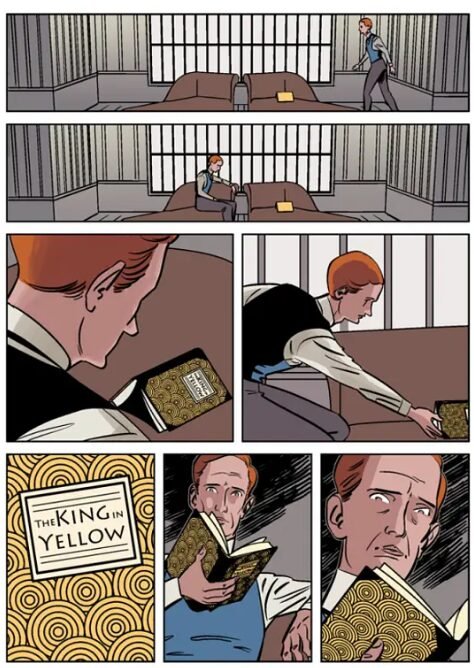Creator: I.N.J. Culbard
(Based on a work by Robert W. Chambers, 1895)
Self Made Hero, 2015

Surely one of the sharpest comics to be published in recent years, The King in Yellow‘s back cover introduces us to the eeriness of the subject matter: “Strange is the night where black stars rise, And strange moons circle through the skies…””
Here is the promotional copy from publisher, Self Made Hero:
The King in Yellow: a play that brings madness to all who read it. Irresistible and insidious, it lures the reader with its innocence and dooms them with its corruption. In a series of interlinked stories, Robert W. Chambers’ classic work of weird fiction shows the creeping spread of the play’s macabre touch. I.N.J. Culbard’s deft and unsettling adaptation (newly reissued in a smaller format, with a foreword by Dan Abnett and a new cover) breathes life into Chambers’ influential masterpiece, expertly revealing the malice and mayhem that await those unlucky enough to turn the wrong page.

We were not familiar with Robert W. Chambers’ original text, but now having read this title and explored the background courtesy of Google, we are not surprised that it influenced the likes of HP Lovecraft. Mr Chambers published The King in Yellow in 1895, before, curiously, going on to write romantic fiction. The original 1895 version of The King in Yellow consisted of ten stories which make reference to a play, also named The King in Yellow. We are exposed only to snippets of a grand and alien text. Whenever a character through misfortune or stupidity reads the play, it fills the reader with a void of sorrow, horror, and even madness.
A review from the British Fantasy Society https://www.britishfantasysociety.org/reviews/the-king-in-yellow-comic-review/ describes the last chapter as “the weakest link”. We entirely disagree. In days before instant gratification became the default for horror, monster movies left the reveal of the bête noire to the very end. That certainly happens here, and admirably so. As the story progresses, the strangeness snowballs, such that at the beginning of the comic the characters are odd but not fantastic, but by the end the antagonists are the stuff of nightmares. Towards the end of the comic, the pace accelerates. We are steered between flickering and unsettling scenes which remind us of the conclusion of 2001: A Space Odyssey: unrecognisable and sudden shifts in backdrop, the inexplicable presence of two of the characters – both dead – from earlier in the story, and finally a descent into a deceptively golden light.

Throughout the text, writer and artist I.N.J. Culbard pays a special emphasis on the eyes of the characters – hooded, staring, glaring, and increasingly demonic. They stare at us. It is with some satisfaction that the King in Yellow is entirely hooded. We wonder how Mr Culbard might have done the eyes of the ultimate terror any justice. Just as the play is an exercise in despair and insanity, surely the King in Yellow’s gaze must not be met. Yellow is no colour of happiness in this comic. It is instead jaundiced and sickly, and it is an appropriate hue of the eyes of those agents of the King which we see in the last chapter – the horrible dough man and the looming organ player.
We read this comic several times, and with each read, like the fictional play which underpins the story, we became more and more disturbed. This is a slick, wonderful example of the genre.

